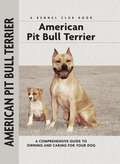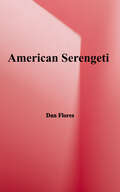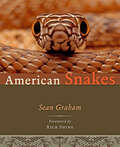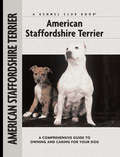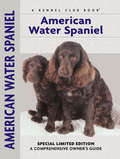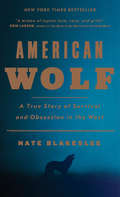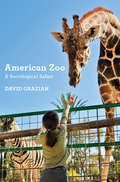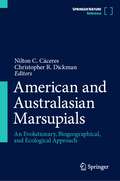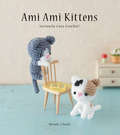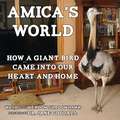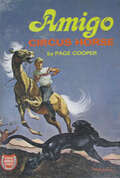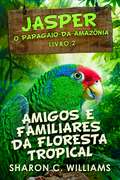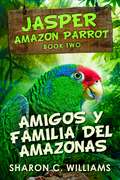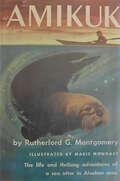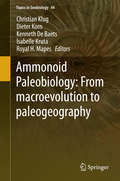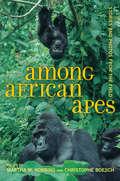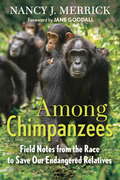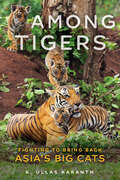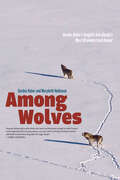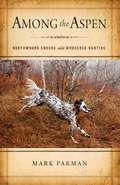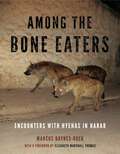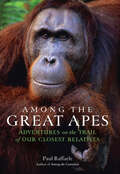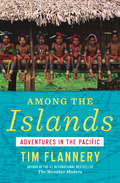- Table View
- List View
American Pit Bull Terrier
by F. FavoritoThis Comprehensive Owner's Guide to the American Pit Bull Terrier serves as a complete introduction to the dog who can do virtually anything, regarded by his owners as the smartest, most devoted, and most versatile dog in existence. Despite the breed's controversial beginnings as a fighting dog and reams of bad press it has garnered in contemporary times, lovers of the APBT defend the breed as one of the true red, white, and blue originals, worthy of high praise for its flawless devotion. Author F. Favorito sits firmly in this camp and details the breed's origins without apology, offering fascinating insight and detail that all breed lovers will relish. The author continues with chapters on characteristics and the breed standard encapsulating all of the virtues of this one-of-a-kind working terrier breed, offering sound advice about which owners are best suited (and worthy) to own this potentially challenging breed.New owners will welcome the well-prepared chapter on finding a breeder and selecting a healthy, sound puppy. Chapters on puppy-proofing the home and yard, purchasing the right supplies for the puppy as well as house-training, feeding, and grooming are illustrated with handsome adults and puppies bursting with energy and personality! In all, there are over 135 photographs in this compact, useful, and reliable volume. The author's advice on obedience training the ever-ready Pit Bull will help readers better mold and train their dogs into the most socialized, well-mannered bully in the neighborhood. The extensive chapter on healthcare provides detailed information on selecting a qualified veterinarian, vaccinations, parasites, infectious diseases, and more. Sidebars throughout the text offer helpful hints, covering topics as diverse as toxic plants, bloat, first aid, crate training, carsickness, fussy eaters, and parasite control. Fully indexed.
American Serengeti: The Last Big Animals of the Great Plains
by Dan FloresAmerica's Great Plains once possessed one of the grandest wildlife spectacles of the world, equaled only by such places as the Serengeti, the Masai Mara, or the veld of South Africa. Pronghorn antelope, gray wolves, bison, coyotes, wild horses, and grizzly bears: less than two hundred years ago these creatures existed in such abundance that John James Audubon was moved to write, "it is impossible to describe or even conceive the vast multitudes of these animals." In a work that is at once a lyrical evocation of that lost splendor and a detailed natural history of these charismatic species of the historic Great Plains, veteran naturalist and outdoorsman Dan Flores draws a vivid portrait of each of these animals in their glory--and tells the harrowing story of what happened to them at the hands of market hunters and ranchers and ultimately a federal killing program in the nineteenth and twentieth centuries. The Great Plains with its wildlife intact dazzled Americans and Europeans alike, prompting numerous literary tributes. American Serengeti takes its place alongside these celebratory works, showing us the grazers and predators of the plains against the vast opalescent distances, the blue mountains shimmering on the horizon, the great rippling tracts of yellowed grasslands. Far from the empty "flyover country" of recent times, this landscape is alive with a complex ecology at least 20,000 years old--a continental patrimony whose wonders may not be entirely lost, as recent efforts hold out hope of partial restoration of these historic species. Written by an author who has done breakthrough work on the histories of several of these animals--including bison, wild horses, and coyotes--American Serengeti is as rigorous in its research as it is intimate in its sense of wonder--the most deeply informed, closely observed view we have of the Great Plains' wild heritage.
American Snakes
by Sean P. GrahamThe captivating and beautifully illustrated true story of snakes in America.125 million years ago on the floodplains of North America, a burrowing lizard started down the long evolutionary path of shedding its limbs. The 60-plus species of snakes found in Sean P. Graham's American Snakes have this ancestral journey to thank for their ubiquity, diversity, and beauty. Although many people fear them, snakes are as much a part of America's rich natural heritage as redwoods, bald eagles, and grizzly bears. Found from the vast Okefenokee Swamp to high alpine meadows, from hardwood canopies to the burning bottom of the Grand Canyon, these ultimate vertebrates are ecologically pivotal predators and quintessential survivors.In this revelatory and engaging meditation on American snakes, Graham, a respected herpetologist and gifted writer, • explains the everyday lives of American snakes, from their daily routines and seasonal cycles to their love lives, hunting tactics, and defensive repertoires• debunks harmful myths about snakes and explores their relationship with humans• highlights the contribution of snakes to the American wilderness• tells tales of "snake people"—important snake biologists with inspiring careersNeither a typical field guide nor an exhaustive reference, American Snakes is instead a fascinating study of the suborder Serpentes. Brimming with intriguing and unusual stories—of hognose snakes that roll over and play dead, blindsnakes with tiny vestigial lungs, rainbow-hued dipsadines, and wave-surfing sea-snakes—the text is interspersed with scores of gorgeous full-color images of snakes, from the scary to the sublime. This proud celebration of a diverse American wildlife group will make every reader, no matter how skeptical, into a genuine snake lover.
American Snakes
by Sean P. Graham“A wonderful book to read because it is replete with snake stories, personal stories, and stories about other herpetologists . . . engaging.” —CopeiaAlthough many people fear them, snakes are as much a part of America’s rich natural heritage as redwoods, bald eagles, and grizzly bears. Found from the vast Okefenokee Swamp to high alpine meadows, from hardwood canopies to the burning bottom of the Grand Canyon, these ultimate vertebrates are ecologically pivotal predators and quintessential survivors.In this revelatory and engaging meditation on American snakes, Sean P. Graham, a respected herpetologist and gifted writer,explains the everyday lives of American snakes, from their daily routines and seasonal cycles to their love lives, hunting tactics, and defensive repertoiresdebunks harmful myths about snakes and explores their relationship with humanshighlights the contribution of snakes to the American wildernesstells tales of “snake people”—important snake biologists with inspiring careersNeither a typical field guide nor an exhaustive reference, American Snakes is instead a fascinating study of the suborder Serpentes. Brimming with intriguing and unusual stories—of hognose snakes that roll over and play dead, blindsnakes with tiny vestigial lungs, rainbow-hued dipsadines, and wave-surfing sea-snakes—the text is interspersed with scores of gorgeous full-color images of snakes, from the scary to the sublime. This proud celebration of a diverse American wildlife group will make every reader, no matter how skeptical, into a genuine snake lover.“This thoroughly enjoyable book lets readers absorb the excitement of being a herpetologist who works with snakes while learning about the general and specific biology of the creatures.” —Quarterly Review of Biology
American Staffordshire Terrier
by Joseph JanishThis Comprehensive Owner's Guide to the American Staffordshire Terrier serves as a complete introduction to the AmStaff, a tireless working dog that is an unbeatable combination of strength and athleticism. Deriving from bull and terrier crosses in the British Isles, the American Staffordshire Terrier was honed and perfected in the USA and today enjoys a reputation as a wholly trustworthy family and children's companion, top-flight show dog, formidable contender in the obedience ring, and a wonderful therapy dog. Author Joe Janish shares his insight into the origins of the breed and its development in America in a well-researched opening chapter on breed history. He follows with chapters on characteristics and the breed standard encapsulating all of the virtues of this impressive working breed, offering sound advice about which owners are best suited to the breed.New owners will welcome the well-prepared chapter on finding a breeder and selecting a healthy, sound puppy. Chapters on puppy-proofing the home and yard, purchasing the right supplies for the puppy as well as house-training, feeding, and grooming are illustrated with handsome adults and puppies bursting with energy and personality! In all, there are over 135 photographs in this compact, useful, and reliable volume. The author's advice on obedience training the super smart AmStaff will help readers better mold and train their dogs into the most socialized, well-mannered dog in the neighborhood. The extensive chapter on healthcare written by Dr. Lowell Ackerman provides up-to-date detailed information on selecting a qualified veterinarian, vaccinations, parasites, infectious diseases, and more. Further chapters discuss behavioral issues (aggression, digging, barking, etc.), the special care of senior dogs, and showing and competing with the AmStaff in AKC events. Sidebars throughout the text offer helpful hints, covering topics as diverse as historical kennels, toxic plants, first aid, crate training, carsickness, fussy eaters, and parasite control. Fully indexed.
American Water Spaniel
by Paul R. MorrisonA Yankee Doodle original, the American Water Spaniel hails from the state of Wisconsin, where in the town of New London Dr. F. J. Pfeifer developed this all-around sporting dog that could retrieve and flush for the upland hunter. Medium in size and colored in chocolate or liver, the American Water Spaniel excels as both a retriever and a spaniel. Author Paul R. Morrison, an active AWS breeder and sportsman, traces the breed's origins back to Civil War days, chronicling the many legends that have evolved about this curly-coated field spaniel. A friendlier, smarter hunting companion cannot be found-the AWS remains one of America's best kept secrets. This Special Limited Edition also discusses the breed's characteristics as a family dog and hunting dog, his personality and abilities and the breed standard. Each chapter is illustrated with color photographs, making this volume as handsome as it is comprehensive and useful. Chapters on selecting a breeder and puppy, rearing and training the puppy, grooming, feeding and much more provide the owner with a complete guide to this fun-loving spaniel. The book also provides an excellent introduction to dog showing and trialing, sports that welcome enthusiastic newcomers on a weekendly basis. A special chapter on preventive healthcare, written by renowned veterinarian Dr. Lowell Ackerman, provides up-to-date, accurate information on inoculations, parasites, spaying/neutering and much more.
American Wolf: A True Story of Survival and Obsession in the West
by Nate BlakesleeThe enthralling story of the rise and reign of O-Six, the celebrated Yellowstone wolf, and the people who loved or feared her <P><P>Before men ruled the earth, there were wolves. Once abundant in North America, these majestic creatures were hunted to near extinction in the lower 48 states by the 1920s. But in recent decades, conservationists have brought wolves back to the Rockies, igniting a battle over the very soul of the West. With novelistic detail, Nate Blakeslee tells the gripping story of one of these wolves, O-Six, a charismatic alpha female named for the year of her birth. <P><P>Uncommonly powerful, with gray fur and faint black ovals around each eye, O-Six is a kind and merciful leader, a fiercely intelligent fighter, and a doting mother. She is beloved by wolf watchers, particularly renowned naturalist Rick McIntyre, and becomes something of a social media star, with followers around the world. <P><P>But as she raises her pups and protects her pack, O-Six is challenged on all fronts: by hunters, who compete with wolves for the elk they both prize; by cattle ranchers who are losing livestock and have the ear of politicians; and by other Yellowstone wolves who are vying for control of the park’s stunningly beautiful Lamar Valley. <P><P>These forces collide in American Wolf, a riveting multigenerational saga of hardship and triumph that tells a larger story about the ongoing cultural clash in the West—between those fighting for a vanishing way of life and those committed to restoring one of the country’s most iconic landscapes.
American Zoo
by David GrazianOrangutans swing from Kevlar-lined fire hoses. Giraffes feast on celebratory birthday cakes topped with carrots instead of candles. Hi-tech dinosaur robots growl among steel trees, while owls watch animated cartoons on old television sets. In American Zoo, sociologist David Grazian takes us on a safari through the contemporary zoo, alive with its many contradictions and strange wonders. Trading in his tweed jacket for a zoo uniform and a pair of muddy work boots, Grazian introduces us to zookeepers and animal rights activists, parents and toddlers, and the other human primates that make up the zoo's social world. He shows that in a major shift away from their unfortunate pasts, American zoos today emphasize naturalistic exhibits teeming with lush and immersive landscapes, breeding programs for endangered animals, and enrichment activities for their captive creatures. In doing so, zoos blur the imaginary boundaries we regularly use to separate culture from nature, humans from animals, and civilization from the wild. At the same time, zoos manage a wilderness of competing priorities--animal care, education, scientific research, and recreation--all while attempting to serve as centers for conservation in the wake of the current environmental and climate-change crisis. The world of the zoo reflects how we project our own prejudices and desires onto the animal kingdom, and invest nature with meaning and sentiment.A revealing portrayal of comic animals, delighted children, and feisty zookeepers, American Zoo is a remarkable close-up exploration of a classic cultural attraction.
American and Australasian Marsupials: An Evolutionary, Biogeographical, and Ecological Approach
by Nilton C. Cáceres Christopher R. DickmanThis book focuses on the ecology, evolution, biogeography, systematics and taxonomy of New World and Australasian marsupials, greatly expanding the current knowledge base. There are roughly 140 species of New World marsupials, of which the opossum is the best known. Thanks to recent research, there is now an increasing amount of understanding about their evolution, biogeography, systematics, ecology, and conservation in the Americas, especially in South America. There are also some 270 marsupial species in the Australasian region, many of which have been subject to research only in recent years. Based on this information and the authors’ extensive research, this book provides comprehensive insights into the world's marsupials. It will appeal to academics and specialized researchers, students of zoology, paleontology, evolutionary biology, ecology, physiology and conservation, as well as interested non-experts.
Ami Ami Kittens: Seriously Cute Crochet!
by Mitsuki HoshiThe third colorful and imaginative installment in the illustrated amigurumi series, following Ami Ami Dogs and Ami Ami Dogs 2. Amigurumi, which translates to knitted stuffed toy in Japanese, is the art of crocheting cute stuffed animals with large heads and small bodies. Ami Ami Kittens is packed with projects for all crochet lovers offering them directions and inspiration for creating a range of fun and irresistible yarn kittens. Detailed, easy-to-follow instructions, illustrations, and enchanting color photographs teach them how to create these super adorable felines of various breeds and types, including Tabby, Pointed, Black/White Solid, Black and White, Calico, Scottish Fold, Siamese, Russian Blue, Munchkin, Maine Coon, British Shorthair, and American Shorthair. Here, too, are instructions for transforming them into key chains, finger puppets, and magnets. Ami Ami Kittens covers a wide range of techniques, from basic crochet skills perfect for beginners to more challenging patterns for experts, and offers spiral methods to ensure that the stuffing stays inside the finished piece. Filled with pretty, fun, and irresistibly adorable young cats, Ami Ami Kittens provides hours of fun for every knitter-and cat lovers, too.
Amica's World: How a Giant Bird Came into Our Heart and Home
by Jane Goodall Meadow Shadowhawk Washo ShadowhawkAmica is a rhea-a flightless bird in the ratite family, related to ostriches, emus, and kiwis. Amica was adopted as a young chick and in turn quickly adopted mother and son Meadow and Washo Shadowhawk as his flock and made himself at home in their living room.Now an adult, Amica stands nearly six feet tall, and has a six-foot wingspan. By day he roams the backyard, exploring, running, and building nests, along with his friends the chickens and the dog. At night, he watches television and sleeps in the living room with his friend the cat.What's it like living with a rhea? As you'll discover in the words and photos in this book, it is never boring, and requires massive sacrifices. Rheas, which are typically hunted or raised as livestock, are highly intelligent and expressive, with a humanlike range of emotions. Amica's extraordinary story shows the powerful and surprising connections that can be forged between humans and animals.
Amigo: Circus Horse (Famous Horse Stories)
by Page CooperWhen Franz, fifteen-year-old son of the star rider in the circus, saw Amigo, a young palomino, he vowed that he would have that horse for his own and one day make him a great performer. So when Señor Gonzales, who owned Amigo, let Franz exercise him and teach him a few simple dressage steps, he was overjoyed. That was only the beginning, for Amigo was high-spirited, and you couldn't get near him with a saddle. But with the help of his friends, Mulk, the lion tamer's son, and Dizzy, the budding equestrienne from Argentina, Franz began to see his ambition realized. Around this warm story of devotion and friendship between boy and horse: is the exciting, colorful world of the circus, its people and animals. Meet Sadie the elephant, almost too old to perform any more, but not too old to start a stampede, and Mogul the panther, whose escape sent the circus into panic. And there is Madame Fawzia, the snake charmer, daughter of an old Indian medicine man, and the Locatellis, world's most daring aerialists. Here, amid the carnival music and the smell of hot dogs and cotton candy, is an inside look into the lifeblood of a circus: its human and animal performers.
Amigos e Familiares da Floresta Tropical
by Sharon C. WilliamsA vida na selva nunca é chata. Desde o momento em que nasceu, a curiosidade de Jasper o consumiu. Com seu irmão Willie, eles fizeram novos amigos e aprenderam mais sobre a Floresta Amazônica. Os meninos são ótimos amigos. A principal tarefa de Jasper é garantir que seu irmão permaneça seguro, mas é mais fácil falar do que fazer: a selva está cheia de perigos e, se não tomarem cuidado, as coisas podem ficar fora de controle rapidamente. Novos desafios estão sempre ao virar a esquina. Determinado a deixar sua mãe orgulhosa, Jasper promete proteger a si e a seus amigos. Se eles quiserem chegar em casa inteiros, precisam confiar um no outro e naqueles que encontrarem. Também não custa nada ajudar alguém. À medida que descobrem os segredos da Floresta Amazônica, cada nova experiência abre suas mentes para novas possibilidades, e novos amigos fazem suas viagens inesperadas valerem a pena. Embora os problemas tendem a segui-los, Jasper e seus amigos fazem o possível para superar as adversidades e chegar ao topo.
Amigos y Familia del Amazonas
by Sharon C. WilliamsLa vida en la selva nunca es aburrida. Desde el momento que nació, la curiosidad de Jasper lo ha consumido. Con su hermano Willie, han hecho nuevos amigos y han aprendido más sobre la selva Amazónica. Los jóvenes han aprendido a quererse. La responsabilidad principal de Jasper es asegurarse de que su hermano esté a salvo, pero es más fácil decirlo que hacerlo: La jungla está llena de peligros, y si no son cuidadosos, todo se puede salir de control rápidamente. Nuevos desafíos siempre están por venir. Determinado a hacer a su madre orgullosa, Jasper jura proteger a sus amigos y a sí mismo. Si van a volver a casa en una sola pieza, tendrán que confiar en el uno al otro, y en aquellos con los que se encuentren. Nunca está de más ayudar a otros. Mientras descubren los secretos del Amazonas, cada nueva experiencia abre sus mentes a nuevas posibilidades, y los nuevos amigos hacen que sus aventuras inesperadas valgan la pena. A pesar de que los problemas tienden a seguirlos, Jasper y sus amigos hacen todo lo posible para superar las adversidades y salir ganando.
Amikuk
by Rutherford MontgomeryTHIS IS a tale of adventure in the seas around the Aleutian Islands, seas that are populated by sharks and sea lions, whales and porpoises—and sea otters. Amikuk is a young sea otter. As he grows up and learns to swim and dive for his own food, he also learns that the life of a sea otter is full of dangers—from men who will stop at nothing to gain his valuable pelt, from killer whales, and from deadly sharks. In this exciting and unusual story, Amikuk learns to take care of himself in dangerous waters, and—with the help of an unknown friend, an Aleutian boy named Peter—manages to escape from the clubs and bullets of determined hunters. It is Peter who saves Amikuk and his family from certain death more than once—although the otters never know of Peter's guardianship of their lives. Woven into the story are the excitement of a shipwreck, a thrilling contest between a small band of men and a herd of huge sea lions, Amikuk's narrow escapes from sea marauders. All in all, this is a book that will delight all youthful readers.
Ammonoid Paleobiology: From Macroevolution To Paleogeography (Topics in Geobiology #44)
by Christian Klug Dieter Korn Kenneth De Baets Isabelle Kruta Royal H. MapesThis two-volume work is a testament to the abiding interest and human fascination with ammonites. We offer a new model to explain the morphogenesis of septa and the shell, we explore their habitats by the content of stable isotopes in their shells, we discuss the origin and later evolution of this important clade, and we deliver hypotheses on its demise. The Ammonoidea produced a great number of species that can be used in biostratigraphy and possibly, this is the macrofossil group, which has been used the most for that purpose. Nevertheless, many aspects of their anatomy, mode of life, development or paleobiogeographic distribution are still poorly known. Themes treated are biostratigraphy, paleoecology, paleoenvironment, paleobiogeography, evolution, phylogeny, and ontogeny. Advances such as an explosion of new information about ammonites, new technologies such as isotopic analysis, tomography and virtual paleontology in general, as well as continuous discovery of new fossil finds have given us the opportunity to present a comprehensive and timely "state of the art" compilation. Moreover, it also points the way for future studies to further enhance our understanding of this endlessly fascinating group of organisms.
Among African Apes
by Martha M. Robbins Christophe BoeschThese compelling stories and photographs take us to places like Bwindi Impenetrable National Park in Uganda, Ivindo National Park in Gabon, and the Taï National Park in Côte d'Ivoire for an intimate and revealing look at the lives of African wild apes--and at the lives of the humans who study them. In tales of adventure, research, and conservation, veteran field researchers and conservationists describe exciting discoveries made over the past few decades about chimpanzees, bonobos, and gorillas. The book features vivid descriptions of interactions among these highly intelligent creatures as they hunt, socialize, and play. More difficult themes emerge as well, including the threats apes face from poaching, disease, and deforestation. In stories that are often moving and highly personal, this book takes measure of how special the great apes are and discusses positive conservation efforts, including ecotourism, that can help bring these magnificent animals back from the brink of extinction.
Among Chimpanzees
by Jane Goodall Nancy J. MerrickA former student and colleague of Jane Goodall shares stories of chimps and their heroes, and takes readers on a journey to save man's closest relative. Unbeknownst to much of the public, chimps are in trouble: censuses show them to be extinct in four African countries and nearly so in ten others. A large percentage of the remaining populations live in unprotected, increasingly fragmented forests. When Nancy Merrick learned these startling facts in 2009, she decided it was past time to discover the extent to which chimpanzees are at risk across Africa and what can be done. Merrick had begun working with primates in 1972 as a young field assistant in Jane Goodall's famous Gombe camp. Like the rest of the world at the time, she was swept up in the excitement of discovering the remarkable world of chimpanzees--their ability to fashion tools, their dazzling intelligence, and their complex relationships and societies. From that moment on, her human-centered worldview shifted, and she became a devoted advocate for our closest genetic relatives. When Merrick returns to Africa decades later, she's alarmed by how much has changed. Human activity, such as agriculture and logging, has encroached on natural habitats throughout equatorial Africa, endangering chimpanzees, gorillas, and bonobos. In an effort to understand what we can do to save great apes, Merrick connects with primatologists and conservationists who are trying to protect the last great forests. Visits to some of Africa's parks, sanctuaries, and expanding agricultural areas reveal the urgency of the problems and the inspiration of the people leading the search for solutions. Along the way, Merrick demonstrates that the best hope for chimps and other great apes lies in connecting conservation to humanitarian efforts, ensuring a healthy future for animals and humans alike. Among Chimpanzees is at once an inspiring chronicle of Merrick's personal search to learn how chimps are faring across Africa and in captivity, a crucial eyewitness account of a very critical period in their existence, and a rousing call for us to join the efforts to be a voice for the chimpanzees, before it's too late.From the Hardcover edition.
Among Tigers: Fighting to Bring Back Asia's Big Cats
by K. Ullas KaranthToday ten times more tigers live in captivity than survive in the wild. For over five decades, K. Ullas Karanth has been engaged in the struggle to bring wild tigers back from the brink in India, their last remaining wild stronghold. He tells the story of the tiger itself—its incredible biology, its critical role in shaping natural ecosystems of Asia, and the unique place it holds in our collective imagination.Among Tigers is the story of how we wound up with fewer than 5,000 wild tigers, and how, with focused efforts we can grow that population ten times or more in a few decades. In doing so, we would bring not only the world's largest and most beloved feline back from the brink, but also save countless other species that share the tigers habitats from the freezing forests of Siberia to the tropics of India. Karanth shares the adventurous real-life story of his quest to save a species and, along the way, the hopeful realization that tiger conservation is a battle that can be won.Ultimately, the book is a roadmap showing us how to not only to save the greatest of great cats, but to bring it roaring back at numbers never before seen in our lifetimes.
Among Wild Horses: A Portrait of the Pryor Mountain Mustangs
by Hope Ryden Lynne PomeranzSee the wild horses run! The Pryor Mountain Mustangs have roamed the high desert and mountains of the American West for centuries. Descended from steeds brought over by the Spanish conquistadores, their untamable nature and enduring courage inspire awe in all who have the chance to see them. Photographer Lynne Pomeranz spent two years with these magnificent creatures along the Montana-Wyoming state line, and her startlingly intimate photographs capture the resilience and free spirit that define these mustangs.
Among Wolves: Gordon Haber's Insights into Alaska's Most Misunderstood Animal
by Marybeth Holleman Gordon HaberAlaska’s wolves lost their fiercest advocate, Gordon Haber, when his research plane crashed in Denali National Park in 2009. Passionate, tenacious, and occasionally brash, Haber, a former hockey player and park ranger, devoted his life to Denali’s wolves. He weathered brutal temperatures in the wild to document the wolves and provided exceptional insights into wolf behavior. Haber’s writings and photographs reveal an astonishing degree of cooperation between wolf family members as they hunt, raise pups, and play, social behaviors and traditions previously unknown. With the wolves at risk of being destroyed by hunting and trapping, his studies advocated for a balanced approach to wolf management. His fieldwork registered as one of the longest studies in wildlife science and had a lasting impact on wolf policies. Haber’s field notes, his extensive journals, and stories from friends all come together in Among Wolves to reveal much about both the wolves he studied and the researcher himself. Wolves continue to fascinate and polarize people, and Haber’s work continues to resonate.
Among the Aspen: Northwoods Grouse and Woodcock Hunting
by Mark ParmanFollowing his English setters into thickets in search of grouse and woodcock, Mark Parman feels the pull of older ways and lost wisdom. How rare it is, in our high-tech world, to find oneself completely off the track, bewildered in the wild, and then find the path home by sight and scent and memory. Among the Aspen interweaves tales of companionable dogs, lucky hunts, and favorite coverts where quarry lurks with ruminations on the demise of hunting traditions, the sale of public lands and the privatization of places to hunt, the growing indifference to science, and the loss of wilderness on a planet increasingly transformed by the sprawl of humanity.
Among the Bone Eaters: Encounters with Hyenas in Harar (Animalibus: Of Animals and Cultures #8)
by Elizabeth Marshall Thomas Marcus Baynes-RockBiologists studying large carnivores in wild places usually do so from a distance, using telemetry and noninvasive methods of data collection. So what happens when an anthropologist studies a clan of spotted hyenas, Africa’s second-largest carnivores, up close—and in a city of a hundred thousand inhabitants? In Among the Bone Eaters, Marcus Baynes-Rock takes us to the ancient city of Harar in Ethiopia, where the gey waraba (hyenas of the city) are welcome in the streets and appreciated by the locals for the protection they provide from harmful spirits and dangerous “mountain” hyenas. They’ve even become a local tourist attraction.At the start of his research in Harar, Baynes-Rock contended with difficult conditions, stone-throwing children, intransigent bureaucracy, and wary hyena subjects intent on avoiding people. After months of frustration, three young hyenas drew him into the hidden world of the Sofi clan. He discovered the elements of a hyena’s life, from the delectability of dead livestock and the nuisance of dogs to the unbounded thrill of hyena chase-play under the light of a full moon. Baynes-Rock’s personal relations with the hyenas from the Sofi clan expand the conceptual boundaries of human-animal relations. This is multispecies ethnography that reveals its messy, intersubjective, dangerously transformative potential.
Among the Great Apes: Adventures on the Trail of Our Closest Relatives
by Paul Raffaele“Raffaele spins riveting tales of his mission to visit every species and subspecies of great ape in its natural habitat.” —Discover magazineAward winning adventure journalist Paul Raffaele’s Among the Great Apes is the first book in over a decade—and possibly the last ever—to take its readers into the lives of our charismatic cousins in their native habitats. Humans have long felt a deep attraction to the great apes: bonobos, chimpanzees, orangutans, and gorillas. We see a reflection of ourselves in their faces, mannerisms, and interactions with kin. But we also look to them for contrast. Part of how we define ourselves as human rests with recognizing the differences between us and the great apes, in spite of the substantial amounts of DNA we share.Many great primatologists have dedicated their lives to the observation and study of these species in their natural habitats. Unfortunately, many of these sheltering places no longer exist. The great apes live in some of the most volatile regions on our planet, lands plagued by civil unrest, poverty, environmental degradation, and corrupt governments. In this book, Raffaele goes into the wild to see how our closest relatives are faring today. He takes us through isolated jungles and misty mountain forests, sharing wonderfully intimate observations of ape life paired with the most current research about their behavior.Raffaele, called the “last of the great, old-fashioned adventure writers” by the Washington Post, introduces us to leading conservationists and researchers working to save and study the apes. But best of all, he gets up close to these amazing animals. He describes orangutans fashioning umbrellas from long leaves, a young chimpanzee mothering a “baby” log, and the bonobos’ lively ritual of swinging like gymnasts through the treetops before building elaborate nests to sleep in. Moving from Borneo to the Congo, Among the Great Apes brings us to the natural habitats of all the species and subspecies of the great apes—a trip possible for perhaps the last time.“A powerful account of the author’s journey into our planet’s last remaining gorilla communities.” —The Ecologist“Fantastic. . . . Anyone who cares about animals will benefit hugely from reading it.” —Shaun Ellis, star of Animal Planet’s Living with the Wolfman and author of The Man Who Lives with Wolves“Profound and important . . . Raffaele shows us how amazing interesting and complex great apes are.” —David Greer, coordinator, World Wildlife Fund’s African Great Apes Program
Among the Islands: Adventures in the Pacific
by Tim FlanneryTim Flannery is one of the world’s most influential scientists, credited with discovering more species than Darwin. In Among the Islands Flannery recounts a series of expeditions he made at the dawn of his career to the strange tropical islands of the South Pacific, a great arc stretching nearly 4,000 miles from the postcard perfection of Polynesia to some of the largest, highest, ancient, and most rugged islands on earth. Flannery was traveling in search of rare and undiscovered mammal species, but he found much more: wild, weird places where local taboos, foul weather, dense jungle, and sheer remoteness made for difficult and dramatic exploration. Among the Islands is full of fascinating creatures monkey faced bats, giant fats, gazelle-faced black wallabies, and more and the adventure of discovery. This is an idea read for anyone who has ever imagined voyaging to the ends of the earth to uncover and study the rare and the wonderful.
